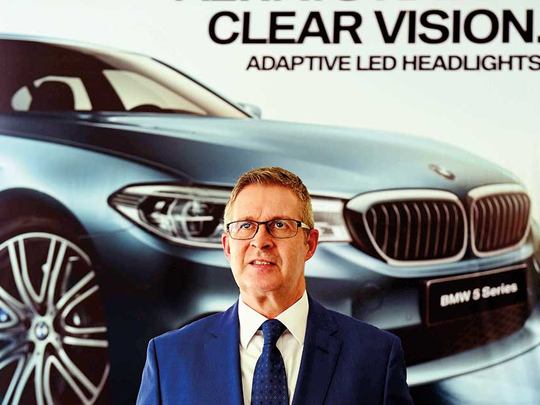
Dubai
UAE’s automotive industry is living on hope … and it’s got a very narrow window to drive through. Their expectation is that enough buyers will troop back into showrooms in the last three months and pick up the latest models. If they do, it can just about compensate for what has been a horror year for car sales in the UAE and the Gulf.
But Johannes Seibert, who heads BMW Group’s Middle East operations, is not one fixated with the future. He’s got enough — and then some — happening right now.
As of May this year, BMW and the MINI recorded gains of 4 and 11 per cent respectively to total 12,000 plus units. And that’s in a marketplace where the overall auto market slid into a 20 per cent decline, while at the premium end the dip was 15 per cent. It is unlikely that other auto brands, irrespective of where they place in the pricing band and the incentives offered, came out with any sort of growth in the year to date.
So, did growth come about as a bit of a surprise? “It wasn’t a surprise — we had a plan (and) we did not reduce shipments or production (meant) for this region,” said Seibert. “We were expecting customer demand will remain stable or even increase — (if) 2016 was the first full-year of the new 7 Series, this year was the first full-year for the 5, and on the MINI side, we had the Countryman as a key model generating additional demand.
“We were confident we had the plan that enables us to sell these volumes. We are focused on maintaining stability with moderate growth. And we do have a healthy profitability in the region.” (The MINI’s 11 per cent volume spike during January to May is particularly impressive, affirming there is still latent demand at the entry level of the premium car category. Plus, the fact that twenty- and thirtysomething drivers — MINI’s core base — are not distancing themselves from the buying process.) Market sources suggest that the biggest drop in volumes have happened at the low to the mid-end of the auto market. Fleet sales too tailed off significantly, as did demand for some of the high-end brands.
In such an environment, will a lot happen in the final three months ahead of the VAT (value-added tax) coming into force? Are there enough buyers willing to take the plunge for the 2018 model year launches and not wait around until VAT makes them just that much more expensive.
Seibert, for one, is not easily swayed by the talk of a “VAT bump” ahead of January next.
“I would not over-evaluate the VAT effect,” the BMW chief said. “It’s not been an easy year in the region — both the (overall car) market and premium segment are declining compared to last year.
“But we plan to have sufficient stocks in case demands pick up. The production I need to have in Q4-17 needs to be built in July-August, latest by September. We will soon make the decisions about the quantities to produce. Every month we have a planning cycle involving our importers. We are speaking about the demand they foresee for Q4-17 for each market, and then agreeing with them on the production quota.
“The VAT of 2018 will be an important issue (and) we do expect certain customers to advance their purchase to Q4-17 and not hold back until 2018. We need to be prepared to have the right stocks in the market to satisfy Q4-17 demand.”
BOX
The X factor that continues to propel BMW’s MidEast drive
* The 14 Middle East markets account for the highest percentage of 7 Series sold by BMW in any of its regions. In the year to May end, that percentage was at a robust 18 per cent of overall volumes BMW shipped out to this region, with the 5 Series accounting for another 10 per cent. “It’s a very different mix from what we see in Europe where customers would focus more on the 3, 2 and 1 Series,” said Johannes Seibert.
* And then there is the X range, now making up 60 per cent of the total, with the X5 easily being the single most sold model across all of the BMW range. “Having 88 per cent of sales from the 7-, 5- and X models have us focusing our marketing strategy on them. The X3 sells extremely well and we are now in the run out (phase). Towards the year end we will launch the successor model.”












